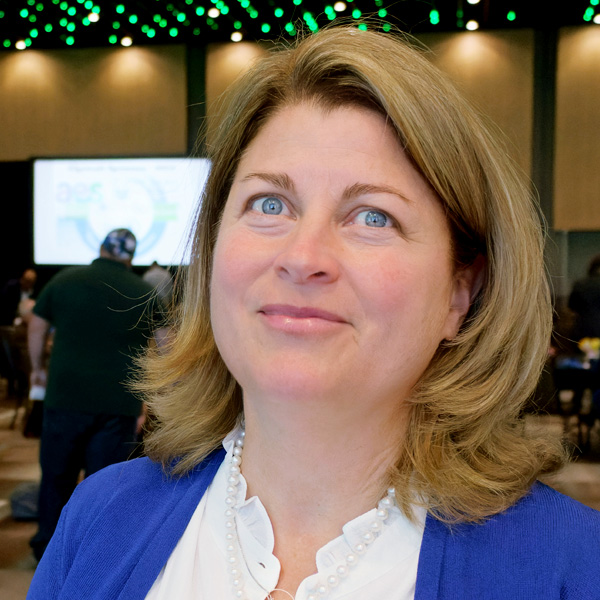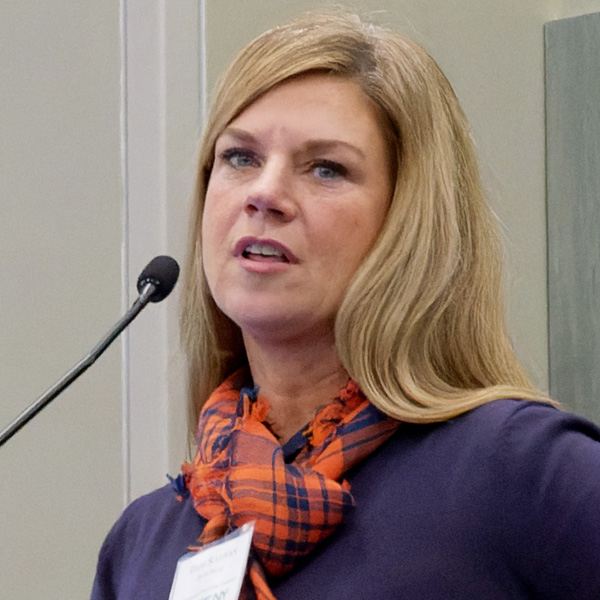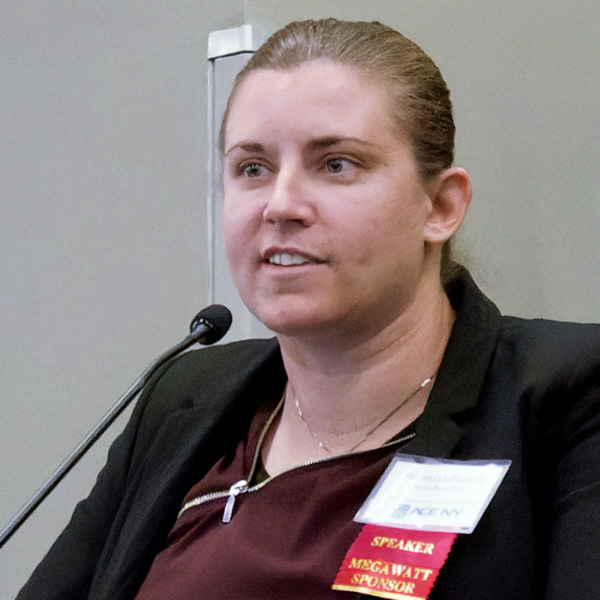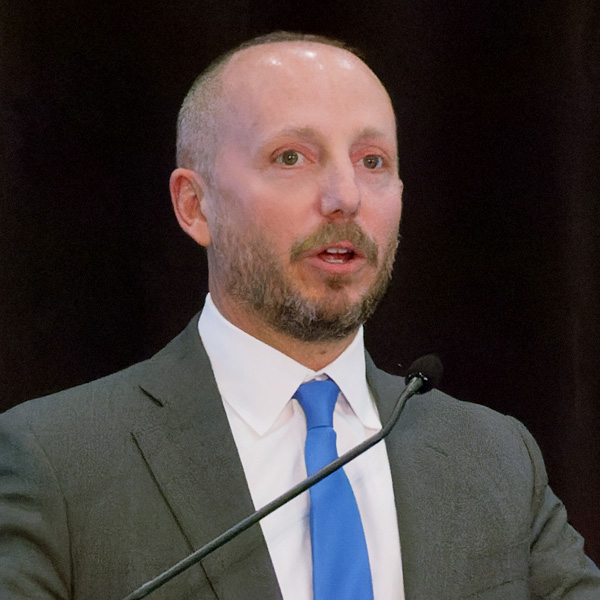ALBANY, N.Y. — With the green energy agenda intact after Election Day and with billions in new funding secured for the energy transition, the fall 2022 conference of the Alliance for Clean Energy NY had a triumphal note.
Speakers at the Nov. 9-10 event celebrated New York voters’ approval of a $4.2 billion environmental bond act and the election of Gov. Kathy Hochul (D), who has continued pushing the ambitious clean energy transition begun by former governor Andrew Cuomo.
With tens of billions in funding expected from federal measures approved earlier this year, the stage is set for extensive progress under New York’s Climate Leadership and Community Protection Act (CLCPA), policymakers said.
 Anne Reynolds, Alliance for Clean Energy New York | © RTO Insider LLC
Anne Reynolds, Alliance for Clean Energy New York | © RTO Insider LLC“Rather than looking forward to the transition in the future, we are in it right now,” ACE NY Executive Director Anne Reynolds said in welcoming attendees. The world needs an example of a sustained and successful transition to carbon-free energy, she said. “I do believe that with your help that New York can be that place that shows the world how to get it done.”
Leaders in the private sector, however, sounded a cautionary note about New York’s regulatory framework, calling it the most expensive and most time-consuming to navigate of any state in the nation.
The state’s top environmental regulator, Department of Environmental Conservation Commissioner Basil Seggos, acknowledged this and said work is underway to change it.
“That’s part of our effort under the CLCPA. We need to not just identify all these opportunities for growth and new programs but also, how do we streamline our processes and ultimately make New York more affordable for developers of clean energy and just New Yorkers in general?” he said.
Optimism and Excitement
Doreen Harris, CEO of the New York Energy Research and Development Authority, said New York is at an inflection point. The extensive groundwork the state has laid toward decarbonization is in line for a massive infusion of federal money from the Inflation Reduction Act (IRA) and other measures — as much as $70 billion, according to a NYSERDA analysis.
 NYSERDA CEO Doreen Harris | © RTO Insider LLC
NYSERDA CEO Doreen Harris | © RTO Insider LLCAlso, New York voters Nov. 8 approved a bond act providing $4.2 billion for environmental projects, about a third of it for green energy and net zero initiatives. New Yorkers voted 2-1 in favor of the bond act, even as they gave a far narrower margin of victory to Hochul. (See Incumbents Successful in Most Contested Governors’ Races.)
“And so we have this moment of tailwind that we are building on here today,” Harris said. “It’s really quite an incredible time.”
Minelly De Coo, deputy director of infrastructure for Hochul, said even if Republicans regain control of the federal government, the transition may slow but it will not stop. “The boat has left the dock,” she said.
De Coo said the tens of billions of federal clean energy dollars coming to New York “is just a drop in the bucket for what is needed.”
But it will have an outsized impact, she added, “because of how far ahead New York state is in implementing and employing some of these programs.”
Harry Godfrey, managing director of Advanced Energy Economy, said manufacturing incentives are the most important part of the IRA. “The U.S. just became a much more attractive place to do business,” he said. “We’re talking about industrial policy we haven’t seen since the beginning of the space race.”
Obstacles on the Path
New York’s challenge is daunting: roughly tripling its generating capacity while simultaneously shifting from dirty-but-constant generation to clean-but-highly-variable power sources.
Some of the speakers tempered their optimism by acknowledging global and local challenges but said these are surmountable. Others centered their comments almost entirely on these challenges, and said they are particularly numerous in one of the most expensive and heavily regulated states in the nation.
 Diane Sullivan, Hecate Energy | © RTO Insider LLC
Diane Sullivan, Hecate Energy | © RTO Insider LLCDiane Sullivan, a senior vice president at renewable developer Hecate Energy, told attendees she had worked as a consultant in all 50 states and that New York has the longest, most expensive siting and permitting process of any of them.
The top three “balance of plant” contractors are not interested in working in New York, and as a result, some other major contractors are hesitant, EDF Renewables Vice President Stephane Desdunes said. The contractors that are willing to work in the state have less experience with grid-scale projects of more than 100 MW, he said.
This reluctance is based on concerns ranging from the shorter northern construction season to New York’s Scaffold Law, which is unique among the 50 states in establishing absolute employer liability for injury in all gravity-related worksite accidents.
Michelle Piasecki of the Harris Beach law firm spoke of the risk of retroactive policymaking. Niagara County, for example, enacted a solar stewardship law that altered the timeline, complexity and financing of multiple projects already in the pipeline. Developers must draw up a recycling plan, pay a review fee, pay an annual fee and face fines of $100 per day per panel for non-compliance, she said.

Stephane Desdunes, EDF Renewables
| © RTO Insider LLCThis is a disincentive to development, Piasecki said, and there is a risk of it spreading to other counties across the state.
Sullivan said the permit issued for Hecate’s 500-MW Cider Solar project east of Buffalo had extensive checkoff lists and ran 78 pages — a red flag for contractors considering bidding on it.
“There seems to be a conflict between how NYSERDA screens projects vs. how the NYISO does,” Cypress Creek Renewables CEO Sarah Slusser said. “[They are] basically at odds with each other — one screens for concentration the other screens for lack of concentration of facilities. That kind of needs to align. That kind of coordination would greatly help.”
ACE NY’s Reynolds acknowledged the concern.
“I’ve never developed projects in other states but I’m talking to developers all the time, and you can get a permit and get an interconnection so much faster in other places,” she said.
 Michelle Piasecki, Harris Beach law firm | © RTO Insider LLC
Michelle Piasecki, Harris Beach law firm | © RTO Insider LLC“I’m still optimistic but … you have so many moving parts. You have the interconnection process, you have transmission constraints, you have permitting, you have getting a NYSERDA contract and then you have to negotiate a tax agreement.”
The review and permitting processes pose the biggest challenge, speakers said. During a review that can take three to five years, key factors such as technology, landowner consent, local politics and interconnection capacity can change. A change of detail as minor as the manufacturer’s model name for a solar panel prompts a material modification review by NYISO.
George Pond of the law firm Barclay Damon said NYISO — which is currently advertising 38 job vacancies — does not have the capacity to catch up with the volume of projects coming to it for review.
 George Pond, Barclay Damon law firm | © RTO Insider LLC
George Pond, Barclay Damon law firm | © RTO Insider LLC“I know that NYISO is struggling; I would say the biggest thing they need is more engineers,” he said. “In a sense I want to give a shout-out to them … they have a lot more projects in their class-year facilities study now than they did when the process was set up 20 years ago, and they’re managing to keep the timeline about where it’s been. So you shouldn’t overlook all the hard work they’ve done to get to that point.”
Another major challenge is the difficulty obtaining equipment and labor. The wait time for parts delivery has increased. Delivery of a substation inverter, for example, might take 18 to 24 months. In addition, contractors are submitting bids valid for as little as 30 days due to price volatility.
With the increasing number of renewable projects, there is intense competition for workers and much of the work requires union labor and minority- and women-owned business enterprise (MWBE) participation.
While New York needs thousands of new electricians and other skilled tradesmen, workforce development programs often require a multiyear commitment that potential students are unable or unwilling to make.
The environmental justice and economic development component of New York’s clean energy transition is extensive and highly detailed. A 45-part scoring system will be used to determine if a community is economically disadvantaged, and it is being “continuously recalibrated,” according to Sameer Ranade of NYSERDA.
The Path Forward
In an interview, Seggos said the permitting concerns are valid, but they are being addressed by shifting responsibility from the DEC and the Department of Public Service to the state’s new Office of Renewable Energy Siting.
“Now you’re seeing projects move through there more quickly and hopefully get their permits,” Seggos said. “They need to be coming in with the right applications — we encourage pre-consultations so that a developer isn’t selecting a hundred acres of wetland, which happens, even still.”
Reynolds offered an optimistic take despite all the factors complicating New York’s transition.
 N.Y. Department of Environmental Conservation Commissioner Basil Seggos | © RTO Insider LLC
N.Y. Department of Environmental Conservation Commissioner Basil Seggos | © RTO Insider LLC“It’s definitely a lot; I don’t want to minimize it,” she said. “I’m hoping that it’s not unrealistic, and we do have 17 projects under construction this year, which is more than we’ve ever had before.
“I think the question you’re asking is, ‘If we keep hanging all these ornaments on the Christmas tree, will it eventually fall over?’ I’m still hopeful it won’t. It hasn’t happened yet; people are still coming to develop in New York, and there’s these projects under construction.
“But it’s also predicated on an even playing field. So, if all the solar companies have the same requirements … then it should work. And I think that’s what we’re counting on.”
Seggos said the technological challenges facing the engineers and scientists who will make the transition possible are exceeded by the societal challenge of carrying out such an enormous change.
Seggos compared it to simultaneously redesigning and building a plane while deciding where to go, navigating it to that location, and safely landing.
“What we’re trying to accomplish is to effectively undo a hundred years of how the state was built and regulated and adapt it to the current needs — without upsetting the apple cart along the way,” he said.
“It’s an extraordinary challenge.”


